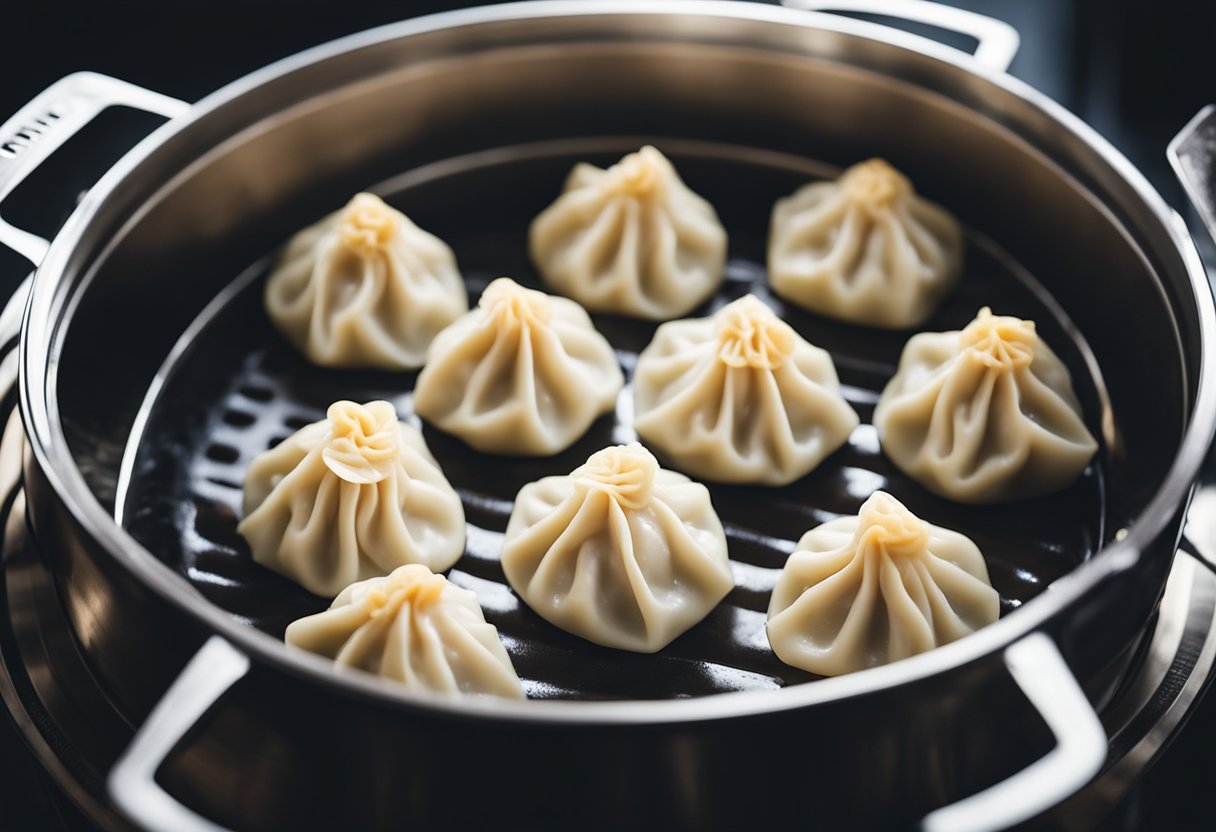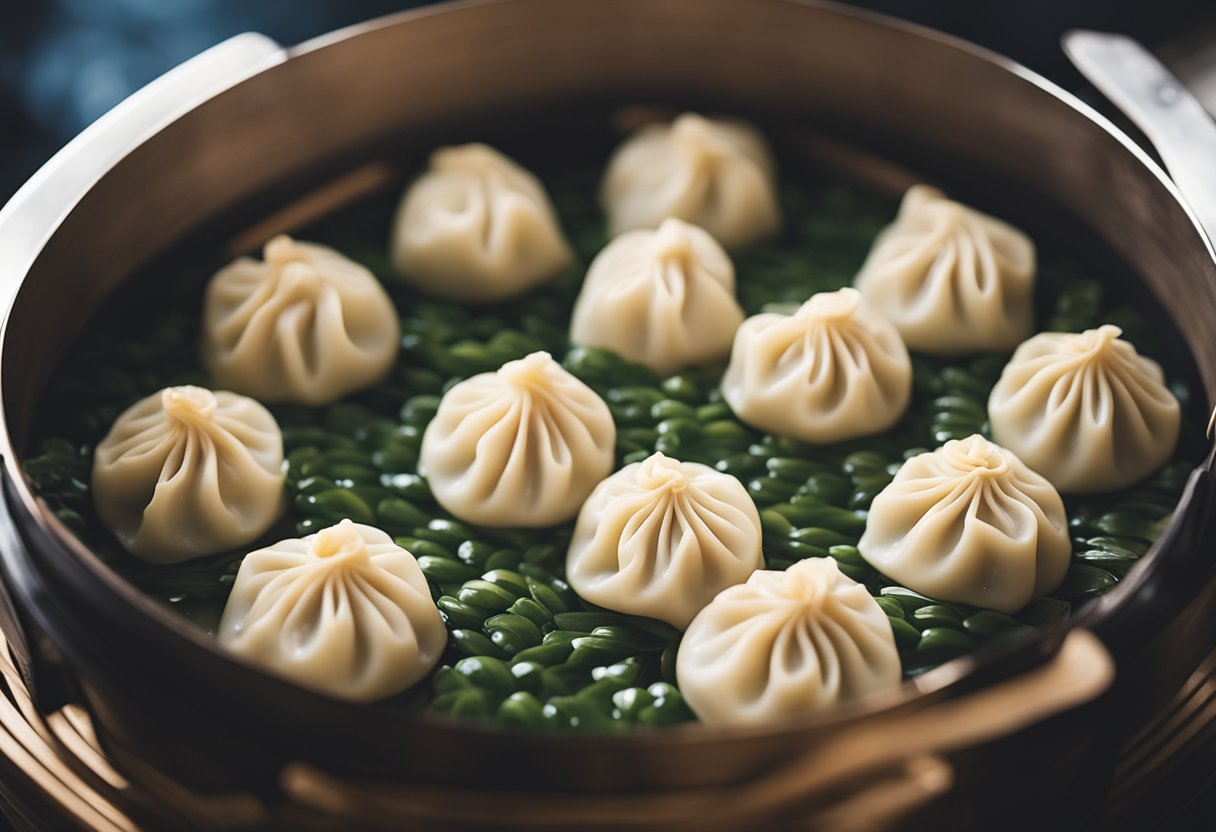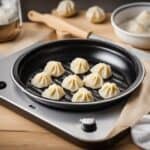As a lover of soup dumplings, I know how important it is to reheat them properly to maintain their texture and deliciousness.
Whether you have leftover dumplings from a restaurant or you made a big batch at home, reheating them can be tricky. But fear not! With the right technique, you can enjoy your soup dumplings just as much as when they were freshly made.

There are several ways to reheat soup dumplings, including steaming, pan-frying, microwaving, and boiling. However, not all methods are created equal, and some may result in soggy or chewy dumplings.
In this article, I will share with you the best techniques for reheating soup dumplings to ensure that they are just as tasty as when you first had them.
I will also provide tips for maintaining their texture and flavor, as well as how to store leftovers for future use.
Key Takeaways
- Proper preparation before reheating is key to maintaining the texture and flavor of soup dumplings.
- Steaming is the best method for reheating soup dumplings, but pan-frying and boiling can also work well.
- To maintain the texture and flavor of soup dumplings, it is important to avoid overcooking or overheating them, and to store leftovers properly.
Types and Characteristics of Dumplings

As a dumpling enthusiast, I have tried and tasted several types of dumplings. Dumplings are a versatile dish that can be found in various cultures and cuisines.
They are typically small pieces of dough filled with meat, vegetables, or other ingredients. Here are some of the most popular types of dumplings and their characteristics:
Xiao Long Bao
Xiao Long Bao, also known as soup dumplings, are a type of Chinese dumpling that originated from Shanghai. They are filled with pork and a savory broth that turns into soup when steamed.
Xiao Long Bao is delicate and requires careful handling when reheating. It is best to use a steamer or microwave to avoid tearing the dumpling skin.
Gyoza
Gyoza is a Japanese dumpling that is similar to Chinese Jiaozi. They are typically filled with ground pork, cabbage, garlic, and ginger. Gyoza is pan-fried on one side and then steamed to cook the filling.
The result is a crispy texture on the bottom and a soft texture on the top. Gyoza is best reheated in a pan with a small amount of water to create steam.
Baozi
Baozi is a Chinese steamed bun filled with meat, vegetables, or sweet fillings. They are typically larger than other types of dumplings and can be eaten as a meal.
Baozi is best reheated in a steamer to maintain its soft texture.
Wonton
Wonton is a Chinese dumpling that is typically filled with pork and shrimp. They are usually served in a soup or deep-fried. Wonton is best reheated in a steamer or microwave.
Guo Tie
Guo Tie, also known as potstickers, are a Chinese dumpling that is pan-fried on one side and then steamed to cook the filling. They are typically filled with pork and cabbage. Guo Tie is best reheated in a pan with a small amount of water to create steam.
Mandu
Mandu is a Korean dumpling that is typically filled with ground beef, pork, or vegetables. They are usually boiled or pan-fried. Mandu is best reheated in a steamer or microwave.
Jiaozi
Jiaozi is a Chinese dumpling that is typically filled with ground pork, cabbage, and ginger. They are usually boiled or pan-fried. Jiaozi is best reheated in a steamer or microwave.
Pierogi
Pierogi is a Polish dumpling that is typically filled with potatoes, cheese, or meat. They are usually boiled or pan-fried. Pierogi is best reheated in a pan with a small amount of water to create steam.
Har Gow
Har Gow is a Chinese dumpling that is typically filled with shrimp and bamboo shoots. They are usually steamed and served with soy sauce. Har Gow is best reheated in a steamer or microwave.
Shumai
Shumai is a Chinese dumpling that is typically filled with pork and shrimp. They are usually steamed or deep-fried. Shumai is best reheated in a steamer or microwave.
In conclusion, each type of dumpling has its own unique characteristics and requires different methods for reheating. It is important to handle them with care to avoid tearing the skin or overcooking the filling.
Preparation Before Reheating

Before reheating your soup dumplings, it is important to properly store them to maintain their quality.
If you have leftover soup dumplings, you can store them in an airtight container or a freezer bag in the refrigerator for up to 3 days. If you want to keep them longer, you can freeze them for up to a month.
To freeze soup dumplings, place them in a single layer on a baking sheet and freeze for an hour. Once they are frozen, transfer them to an airtight container or a freezer bag and label them with the date.
When you are ready to reheat them, defrost them in the refrigerator overnight or on the counter for a few hours.
It is important to note that freezing dumplings can affect their texture, so it is best to freeze them only if you plan to reheat them later.
If you want to freeze dumpling dough, you can do so by wrapping it tightly in plastic wrap and placing it in an airtight container or freezer bag.
Before reheating your soup dumplings, make sure they are at room temperature. If they are frozen, defrost them first. Reheating frozen soup dumplings can cause them to become soggy and lose their flavor.
In summary, proper storage is crucial to maintain the quality of your soup dumplings. If you have leftover soup dumplings, store them in an airtight container or freezer bag in the refrigerator for up to 3 days or freeze them for up to a month.
Make sure to defrost them before reheating and be aware that freezing can affect their texture.
Reheating Techniques
When it comes to reheating soup dumplings, there are a few techniques that work well. Depending on your available resources and time constraints, you may prefer one method over another.
Here are the three most popular ways to reheat soup dumplings:
Steaming
Steaming is the best way to reheat soup dumplings, as it keeps the dumplings moist and prevents the filling from drying out. To steam soup dumplings, you will need a steamer basket and a pot of boiling water.
Place the dumplings in the steamer basket and cover with a lid. Place the basket in the pot of boiling water and steam for 3-5 minutes. Make sure to keep an eye on the water level and add more water if necessary.
Microwaving
Microwaving is a quick and easy way to reheat soup dumplings, but it can be tricky to get the timing right. To microwave soup dumplings, place them on a microwave-safe plate and cover with a microwave-safe lid or plastic wrap.
Microwave on high power for 30 seconds to 1 minute, depending on the strength of your microwave. Check the dumplings and continue microwaving in 10-second intervals until they are heated through.
Oven Reheating
Oven reheating is a great option if you have a large batch of soup dumplings to reheat. To oven reheat soup dumplings, preheat your oven to 350°F. Place the dumplings on a baking sheet lined with aluminum foil and cover with another sheet of foil.
Bake for 10-15 minutes or until heated through. For extra crispy skin, remove the top layer of foil and broil for 1-2 minutes.
No matter which method you choose, make sure to add a small amount of water to the bottom of the pot or dish to prevent the dumplings from sticking.
And be careful not to overcook the dumplings, as they can become tough and chewy if reheated for too long.
Important Tips for Maintaining Texture and Flavor

Maintaining the texture and flavor of soup dumplings is crucial for a delicious meal. Here are some tips to help you achieve the best results:
- Use gentle reheating methods: To maintain the delectable taste of dumplings while reheating, opt for gentle methods. Steaming is ideal, as it retains moisture and flavor. Use a steamer and warm for 3-4 minutes. Microwaving works if done cautiously.
- Be mindful of cooking time: Overcooking can cause the filling to dry out and the wrapper to become rubbery. Make sure to keep an eye on the cooking time and remove the dumplings from heat as soon as they are cooked through.
- Use the right amount of water: When boiling or steaming dumplings, make sure to use enough water to cover them. This will prevent them from sticking to the bottom of the pot or steamer.
- Don’t overcrowd the pot or steamer: Overcrowding can cause the dumplings to stick together and cook unevenly. Make sure to leave enough space between each dumpling.
- Use the right dipping sauce: Dipping sauces can enhance the flavor of soup dumplings. Popular options include vinegar, chili oil, and sesame oil. Experiment with different combinations to find your favorite.
- Handle with care: Soup dumplings are delicate and can easily break open if mishandled. Use a fork or spatula to remove them from the pot or steamer, and be careful when cutting them open.
- Store leftovers properly: If you have leftover soup dumplings, store them in an airtight container in the refrigerator. To reheat, place them in a steamer or microwave and warm for a few minutes. Use a damp paper towel to prevent them from drying out.
By following these tips, you can enjoy delicious and flavorful soup dumplings every time. Whether you prefer steamed or fried dumplings, potstickers, or soup dumplings, these tips will help you achieve the perfect texture and flavor.
Storing Leftovers for Future Use

When it comes to storing leftover soup dumplings, there are a few things to keep in mind. First, it’s important to store them properly to ensure that they stay fresh and safe to eat.
Second, you want to make sure that they are easy to reheat when you’re ready to enjoy them again.
One of the best ways to store leftover soup dumplings is to place them in an airtight container. This will help to keep them fresh and prevent them from drying out. You can also use a freezer bag if you plan on freezing them.
If you’re planning on freezing your leftover soup dumplings, it’s important to make sure that they are completely cooled before placing them in the freezer.
This will help to prevent freezer burn and ensure that they taste just as good when you’re ready to eat them again.
When it comes to reheating frozen soup dumplings, it’s best to steam them rather than microwaving them. Microwaving can cause the dumplings to become tough and rubbery, whereas steaming will help to keep them moist and tender.
If you’re storing leftover soup dumplings in the refrigerator, they should be eaten within two to three days. If you’re planning on freezing them, they can be stored for up to three months.
Overall, storing leftover soup dumplings is a great way to make sure that you always have a delicious meal on hand. By following these simple tips, you can ensure that your dumplings stay fresh and tasty for future use.
Frequently Asked Questions

What’s the best way to reheat frozen soup dumplings?
If you have frozen soup dumplings, it’s best to thaw them in the refrigerator overnight before reheating them. Once they are thawed, you can reheat them using a steamer or a microwave.
If using a steamer, place the dumplings in a steamer basket and steam for 5-7 minutes. If using a microwave, place the dumplings on a microwave-safe plate, cover with a damp paper towel, and microwave for 1-2 minutes.
How do you reheat Din Tai Fung dumplings?
Din Tai Fung dumplings can be reheated using a steamer or a microwave. If using a steamer, place the dumplings in a steamer basket and steam for 5-7 minutes.
If using a microwave, place the dumplings on a microwave-safe plate, cover with a damp paper towel, and microwave for 1-2 minutes.
How do you reheat momos?
Momos can be reheated using a steamer or a microwave. If using a steamer, place the momos in a steamer basket and steam for 5-7 minutes.
If using a microwave, place the momos on a microwave-safe plate, cover with a damp paper towel, and microwave for 1-2 minutes.
How do you reheat Jamaican fried dumplings?
Jamaican fried dumplings can be reheated in a pan on the stove. Heat a small amount of oil in a pan over medium heat. Once the oil is hot, add the dumplings and cook for 2-3 minutes on each side, until they are heated through and crispy.
How do you heat up dumplings without a microwave?
If you don’t have a microwave, you can reheat dumplings using a steamer or a pan on the stove. If using a steamer, place the dumplings in a steamer basket and steam for 5-7 minutes.
If using a pan, add a small amount of oil to the pan and heat over medium heat. Once the oil is hot, add the dumplings and cook for 2-3 minutes on each side, until they are heated through.
How do you store soup dumplings?
Soup dumplings can be stored in an airtight container in the refrigerator for up to 3 days. If you want to freeze them, place them on a baking sheet and freeze until solid.
Once frozen, transfer them to an airtight container or freezer bag and store in the freezer for up to 3 months.







